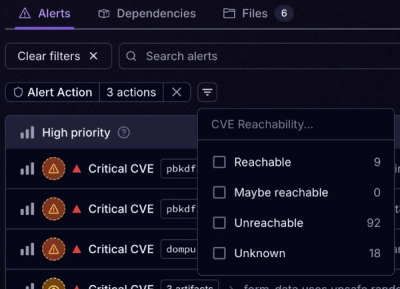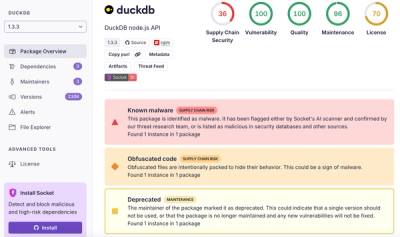
Product
Introducing Tier 1 Reachability: Precision CVE Triage for Enterprise Teams
Socket’s new Tier 1 Reachability filters out up to 80% of irrelevant CVEs, so security teams can focus on the vulnerabilities that matter.
An asynchronous client library for the Twitter REST and Streaming API's.
var Twitter = require('twitter');
var client = new Twitter({
consumer_key: '',
consumer_secret: '',
access_token_key: '',
access_token_secret: ''
});
var params = {screen_name: 'nodejs'};
client.get('statuses/user_timeline', params, function(error, tweets, response) {
if (!error) {
console.log(tweets);
}
});
npm install twitter
You will need valid Twitter developer credentials in the form of a set of consumer and access tokens/keys. You can get these here. Do not forgot to adjust your permissions - most POST request require write permissions.
var Twitter = require('twitter');
var client = new Twitter({
consumer_key: '',
consumer_secret: '',
access_token_key: '',
access_token_secret: ''
});
Add your credentials accordingly. I would use environment variables to keep your private info safe. So something like:
var client = new Twitter({
consumer_key: process.env.TWITTER_CONSUMER_KEY,
consumer_secret: process.env.TWITTER_CONSUMER_SECRET,
access_token_key: process.env.TWITTER_ACCESS_TOKEN_KEY,
access_token_secret: process.env.TWITTER_ACCESS_TOKEN_SECRET
});
You will need to fetch a bearer token from Twitter as documented Here, once you have it you can use it as follows.
var client = new Twitter({
consumer_key: '',
consumer_secret: '',
bearer_token: ''
});
Add your credentials accordingly. I would use environment variables to keep your private info safe. So something like:
var client = new Twitter({
consumer_key: process.env.TWITTER_CONSUMER_KEY,
consumer_secret: process.env.TWITTER_CONSUMER_SECRET,
bearer_token: process.env.TWITTER_BEARER_TOKEN
});
NB - You will not have access to all endpoints whilst using Application Only authentication, but you will have access to higher API limits.
You now have the ability to make GET and POST requests against the API via the convenience methods.
client.get(path, params, callback);
client.post(path, params, callback);
client.stream(path, params, callback);
You simply need to pass the endpoint and parameters to one of convenience methods. Take a look at the documentation site to reference available endpoints.
Example, lets get a list of favorites:
client.get('favorites/list', function(error, tweets, response) {
if(error) throw error;
console.log(tweets); // The favorites.
console.log(response); // Raw response object.
});
How about an example that passes parameters? Let's tweet something:
client.post('statuses/update', {status: 'I Love Twitter'}, function(error, tweet, response) {
if(error) throw error;
console.log(tweet); // Tweet body.
console.log(response); // Raw response object.
});
The REST API convenience methods will also return Promises if:
If those two conditions are met, the above example becomes:
client.post('statuses/update', {status: 'I Love Twitter'})
.then(function (tweet) {
console.log(tweet);
})
.catch(function (error) {
throw error;
})
Note, the raw response object returned by the Request module is not passed through
the fulfilled promise. If you require this, please use the callback pattern.
Using the stream convenience method, you to open and manipulate data via a stream piped directly from one of the streaming API's. Let's see who is talking about javascript:
var stream = client.stream('statuses/filter', {track: 'javascript'});
stream.on('data', function(event) {
console.log(event && event.text);
});
stream.on('error', function(error) {
throw error;
});
// You can also get the stream in a callback if you prefer.
client.stream('statuses/filter', {track: 'javascript'}, function(stream) {
stream.on('data', function(event) {
console.log(event && event.text);
});
stream.on('error', function(error) {
throw error;
});
});
Note twitter stream several types of events, see the docs for more info. There is no canonical way of detecting tweets versus other messages, but some users have had success with the following strategy.
_ = require('lodash')
const isTweet = _.conforms({
contributors: _.isObject,
id_str: _.isString,
text: _.isString,
})
Originally authored by @technoweenie and maintained by @jdub
Currently maintained by @desmondmorris
FAQs
Twitter API client library for node.js
The npm package twitter receives a total of 18,073 weekly downloads. As such, twitter popularity was classified as popular.
We found that twitter demonstrated a not healthy version release cadence and project activity because the last version was released a year ago. It has 2 open source maintainers collaborating on the project.
Did you know?

Socket for GitHub automatically highlights issues in each pull request and monitors the health of all your open source dependencies. Discover the contents of your packages and block harmful activity before you install or update your dependencies.

Product
Socket’s new Tier 1 Reachability filters out up to 80% of irrelevant CVEs, so security teams can focus on the vulnerabilities that matter.

Research
/Security News
Ongoing npm supply chain attack spreads to DuckDB: multiple packages compromised with the same wallet-drainer malware.

Security News
The MCP Steering Committee has launched the official MCP Registry in preview, a central hub for discovering and publishing MCP servers.